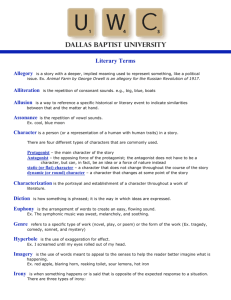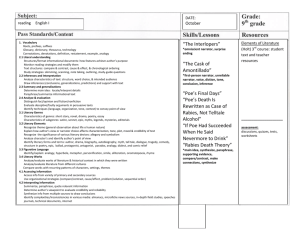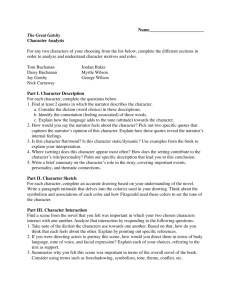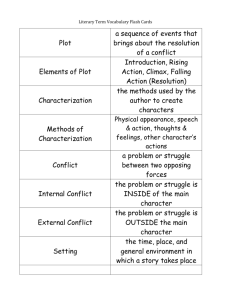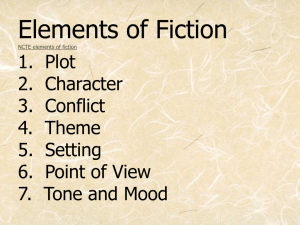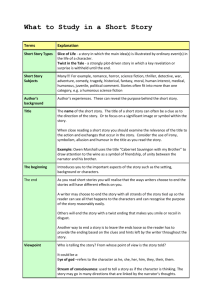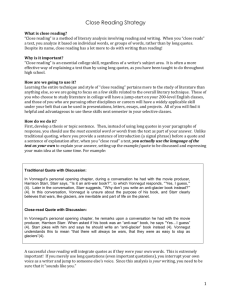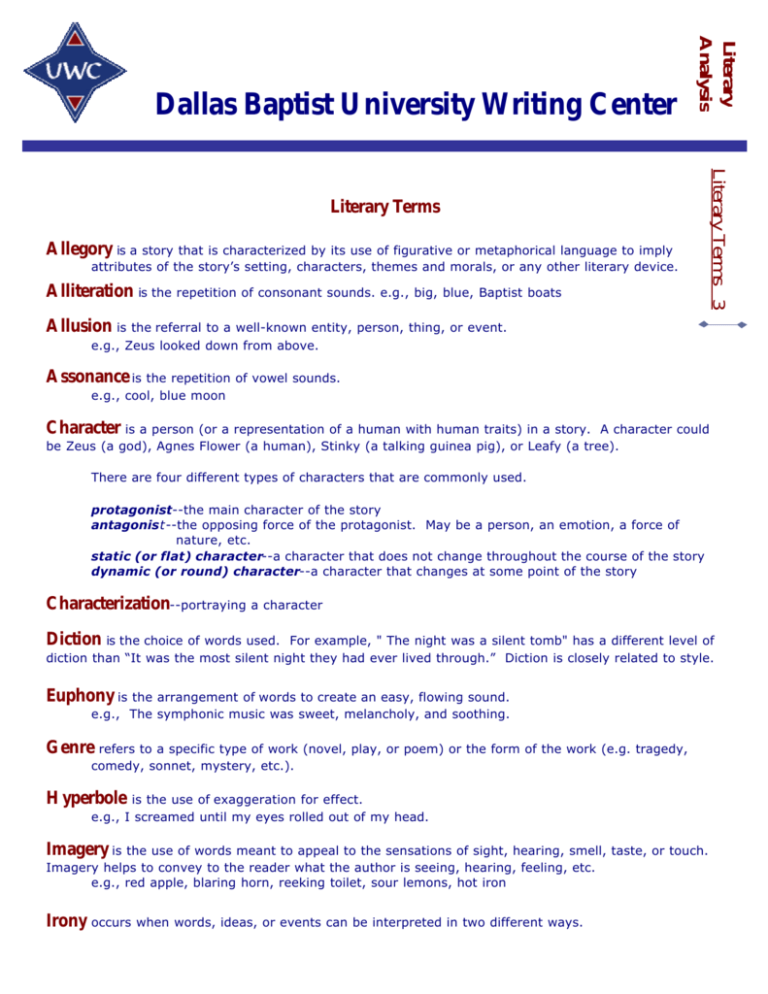
Literary
Analysis
Dallas Baptist University Writing Center
Allegory is a story that is characterized by its use of figurative or metaphorical language to imply
attributes of the story’s setting, characters, themes and morals, or any other literary device.
Alliteration is the repetition of consonant sounds. e.g., big, blue, Baptist boats
Literary Terms 3
Literary Terms
Allusion is the referral to a well-known entity, person, thing, or event.
e.g., Zeus looked down from above.
Assonance is the repetition of vowel sounds.
e.g., cool, blue moon
Character is a person (or a representation of a human with human traits) in a story.
A character could
be Zeus (a god), Agnes Flower (a human), Stinky (a talking guinea pig), or Leafy (a tree).
There are four different types of characters that are commonly used.
protagonist--the main character of the story
antagonist--the opposing force of the protagonist. May be a person, an emotion, a force of
nature, etc.
static (or flat) character--a character that does not change throughout the course of the story
dynamic (or round) character--a character that changes at some point of the story
Characterization--portraying a character
Diction is the choice of words used.
For example, " The night was a silent tomb" has a different level of
diction than “It was the most silent night they had ever lived through.” Diction is closely related to style.
Euphony is the arrangement of words to create an easy, flowing sound.
e.g., The symphonic music was sweet, melancholy, and soothing.
Genre refers to a specific type of work (novel, play, or poem) or the form of the work (e.g. tragedy,
comedy, sonnet, mystery, etc.).
Hyperbole
is the use of exaggeration for effect.
e.g., I screamed until my eyes rolled out of my head.
Imagery is the use of words meant to appeal to the sensations of sight, hearing, smell, taste, or touch.
Imagery helps to convey to the reader what the author is seeing, hearing, feeling, etc.
e.g., red apple, blaring horn, reeking toilet, sour lemons, hot iron
Irony occurs when words, ideas, or events can be interpreted in two different ways.
Three types of irony are commonly used.
verbal irony--saying one thing and meaning another. In Hamlet, Hamlet
speaks to Polonius: "Methinks it is like a weasel" when he speaks of the shape of a cloud.
He is really inferring that Polonius is not to be trusted.
dramatic irony--when the reader knows more than the characters know, e.g., in
Romeo and Juliet, we know that they will die in the end, but they don't know that.
situational irony-- a character is caught in a situation and tries to get out of it but can’t. Usually,
this inescapable situation results in death, e.g., in the story “The Lottery,” the
protagonist tries to get out of an unjust death sentence, but can’t.
Literature is everything that is written and spoken (the oral tradition).
Literature includes four
categories: fiction, non-fiction, poetry, and drama.
Metaphor is a comparison that pictures something unknown as if it were known.
e.g., Her face is a beautiful rose.
Narrative Techniques are devices authors use to vary storytelling style.
These techniques include
flashbacks, foreshadowing, and recurring themes.
Onomatopoeia
is the use of words that sound like the noise they make.
e.g., buzz, roar, tinkle
Paradox is a statement that is seemingly contradictory or opposed to common sense and yet seems
true.
e.g., jumbo shrimp
Personification is giving a non-human thing human attributes.
e.g., The tree waved her arms in the wind.
Plot is the
sequence of events in a story, poem, or play. If the plot were taken away from a story, there
would be nothing left.
There are usually five parts that make up a complete plot.
exposition--the introduction to the story that provides all necessary information at the present
time for the plot to develop
conflict--the struggle between opposing forces
rising action/complication/crisis--when the normal flow of things is disrupted by the conflict(s)
climax--the highest point of the conflict when tension is at its maximum
resolution/falling action--when the conflict is over and things fall back into place
Poetry is a genre which is characterized by rhythmical qualities of language. (The following literary terms
are not applied only in poetry, but are most often associated with poems.)
Point of view
is the position from which the teller of the story sees and relates the story.
Five different points of view are commonly used.
first person narrator—The narrator is part of the action, but has limited
knowledge of the other characters. Told in first person: “I went to the store.” In the story
“Everyday Use” by Alice Walker, the author makes the narrator speak in first person so that
the reader will know only her thoughts.
second person narrator—The narrator tells the reader what you are doing:
“You step towards the lion.” (Often used in Choose-Your-Own-Adventure stories.)
third person objective narrator—The unidentified narrator is not part of the action and reports
only what can be seen and heard.
third person omniscient—The narrator is all-knowing and tells all the characters’ thoughts and
feelings.
third person limited omniscient—The narrator is all-knowing about only one character.
Rhyme is formed by words that have the same ending sound or sounds.
The rhyme is usually at the end
of the line. Tennyson wrote in his poem, The Lady of Shallot, "And when the moon was overhead/ Came
two young lovers lately wed, / 'I am half sick of shadows,' she said."
Rhythm is the beat of poetic lines expressed by the pattern of stressed and unstressed syllables. Robert
Frost wrote his poem, Stopping by Woods on a Snowy Evening, in iambic tetrameter, consisting of
alternating unstressed and stressed syllables.
"Whose woods these are I think I know.
His house is in the village though;
He will not see me stopping here,
To watch his woods fill up with snow."
Setting is the place and the time in which the story takes place.
The setting of the story “The Open Boat”
takes place out in the middle of the ocean in the 1800s.
Simile is a comparison between two things that is marked by the use of "like" or "as." For example, her
face is like a beautiful rose.
Stories are accounts of events and happenings in certain situations.
(The literary terms are not used only
in stories, but we usually think of them in relation to short stories.)
Structure is the way the plot is organized or arranged.
The way a story is structured helps to set the
tone and mood of the story. The way a story is structured will determine how the theme and plot are
perceived.
Style is the way language is used to relate the story to the reader.
It is often controlled by genre. The
style is important because it can make a piece more understandable or more interesting to certain people.
Symbolism is the use of an object or an idea to represent another idea, value, or object.
e.g., dirt on the face or body could represent death.
Syntax
is the order of words and the way the sentences are arranged.
Theme is the central idea, argument, or underlying point of a work of literature, and should be
expressible in a complete sentence. A theme could be “Love grows as a couple matures,” “A wise person
is patient,” “No one can escape death,” or “Be careful what you ask for because it may come true.” It is
important to know the theme of a work.
Tone is created by the style in which the story, poem, play, or essay is delivered.
The tone creates the
mood of the story. One could have a morbid tone (e.g., “An Occurrence at Owl Creek Bridge” by Ambrose
Bearce), or a childlike tone (e.g., “Where the Wild Things Are” by Maurice Sendak).
Original material copyright © Dallas Baptist University. All rights reserved. Other copyrighted material included by permission or
authorization. Created by UWC Staff for Dallas Baptist University. http://www.dbu.edu/uwc




